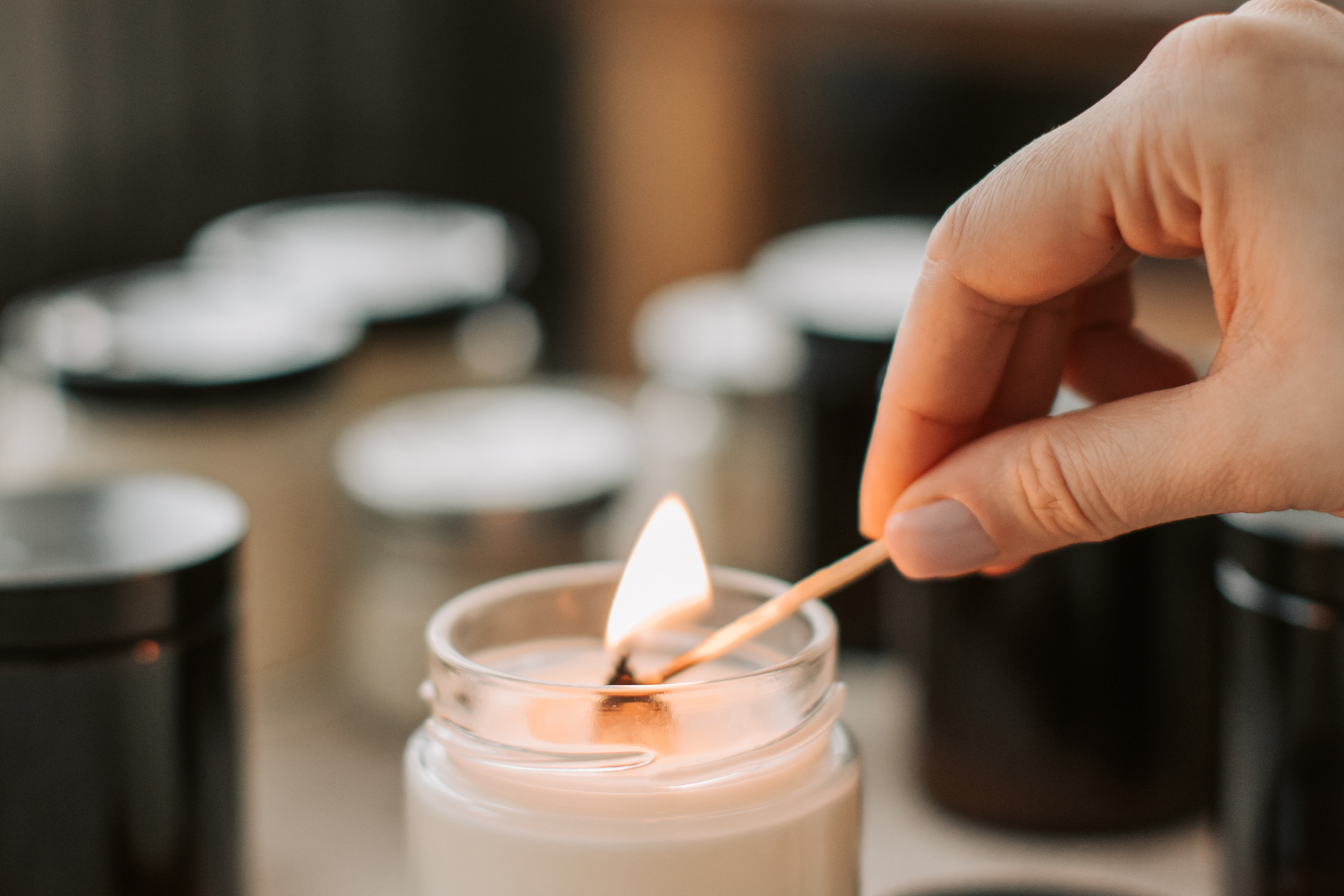Master the art of candle care with 6 essential tips for beginners. Trim wicks, extinguish properly, choose scents wisely, and enhance your ambiance.
Updated December 9, 2024
This might be tough to hear, but you've probably been breaking some fundamental candle-burning rules. We know what you're thinking: "Candles aren’t difficult—don't you just light it and walk away?"
The simple answer is no! Most people unknowingly sabotage their candles and make them last less long with every burn, especially those who blow them out (eek!!
But don't panic! Instead, follow these bonafide Kalamazoo Candle-approved candle care instructions to get the most out of your favorite home decor item.

10 Candle Care Tips: Get The Most Out Of Your Candles
Before you go butchering any more innocent candles, here's what you need to know about how to burn a candle properly.
1. Trim the wick before lighting your candle.
What's the biggest mistake you're making? Not trimming your wicks. Keeping a candle wick properly trimmed helps control the amount of melted wax the candle can reach, which will help reduce the amount of soot it creates.
Properly trimming your wick will also help your candle to burn longer and emit a more potent scent (and who doesn't want that?) Trim the wick to ¼ inch before lighting the candle to ensure a controlled flame.
Pro tip: If you just read that section and thought, “How do I trim a wick?” the answer’s super easy—with a wick trimmer.
2. Allow your candle to melt to the edges on the first burn.
Ever had a candle tunnel down the middle, wasting all that good wax? That’s because you didn’t let it melt to the edges on the first burn. This first burn sets the “wax memory” and determines how your candle will burn in the future.
Make sure to let the wax pool reach the sides of the container (usually 1-2 hours) to avoid tunneling. It’s a little patience now for a lot more cozy candle time later!
3. Avoid drafty areas.
Something that many people don't consider is the location of their candles. For instance, air vents can diffuse that lovely fragrance into oblivion. So be sure to place your candle in a space away from air vents or any breezes flowing through the home (like by open windows or a fan).
4. Only burn your candle for 3-4 hours max.
Letting a candle burn for hours and hours sounds cozy, but it’s not great for your candle. After about 3-4 hours, the jar can get too hot, the wick can “mushroom,” and the flame gets too big. Give your candle a break after a few hours to keep things safe and extend its life.
5. Use a candle wick dipper to put out your candle.
This is not a birthday party, people. Quit blowing out those candles when you're done! And don't even think about pouring water on your candle to put it out—water can cause the hot wax to splatter!
When you simply *poof* out a candle, the core of the wick (both wood and cotton) will continue to burn, creating a carbon-based ash that is both messy and problematic when you decide to relight.
Instead, use a wick dipper to dip your wick into the melted wax of the candle surrounding it to completely snuff out the flame and keep the nasty ash residue at bay.
6. Center the wick after dipping.
Notice your wick leaning to one side after you blow it out? Fix it while the wax is still soft! A centered wick helps the candle burn evenly the next time you light it. Just use a tool or tweezers to gently nudge it back to the middle.
7. Clean off soot buildup.
If you see black soot inside the jar, don’t worry! Just wipe it away with a damp cloth or paper towel. Keeping the jar clean means better-looking candles and less smoky residue.
Soot happens when the wick is too long, or the candle’s in a draft. A quick clean keeps your candle looking fresh and your air soot-free.

8. Use the proper candle ratio to fill the room with fragrance.
Have you ever heard of the candle-burning golden rule? (Okay, we may have made that up, but it's still important). For every 10 square feet of your home, you need at least 8 ounces of a candle to achieve that perfect room-infused scent.
Small living spaces can be filled with scent by one or two small candles without an issue. However, if you have a large room or an area with tall ceilings, you'll need three or four small candles (or one to two large ones) to really fill the space with fragrance.
9. Right fragrance, right time, right place.
Yes, there is a science to the scents you should choose for each area of your home. The right fragrance in the room can set the correct vibe in that space.
For example, fresh, bright scents (like citrus or clean linen) are perfect for areas where freshness is essential— like the bathroom or kitchen. Keeping a space like this smelling tidy will help impress its overall cleanliness upon your visiting friends and family.
For areas like the bedroom, look for scents that promote a sense of calm and peace, like herbal fragrances (lavender, chamomile, eucalyptus, etc.). Rich aromas like these can help entice sleep and keep your room smelling fresh yet cozy.
For communal, larger living spaces, the fragrance world is your oyster—try something seasonal, like floral-scented candles or pumpkin spice candles.
10. Always extinguish candles before leaving the room.
Make it a habit to put out candles before leaving the room, even if it's just for a short period. Seriously–never leave a burning candle unattended, as it can easily ignite nearby objects.
Oh, and be thoughtful if little humans or animals share your home. Place candles in areas where children and pets cannot reach them. When they're old enough, teach children about the dangers of playing with candles and the importance of fire safety.
Common Candle Care Tools
Want to take your candle game from basic to pro-level? Investing in the right candle care tools can seriously enhance your candle experience. These tools not only make burning candles safer and cleaner but also help your favorite scents last longer.
Wick Trimmer
What it does: A wick trimmer keeps your wick at the ideal length (about 1/4 inch) for a cleaner, more controlled burn.
Why you need it: Trimming prevents soot, reduces smoking, and helps your candle last longer. Plus, the long handles and angled design let you reach wicks easily in deeper jars.
Wick Dipper
What it does: A wick dipper extinguishes the flame by dipping the wick into the melted wax, then straightening it again.
Why you need it: No smoke, no burnt smell, just a clean finish. Plus, coating the wick in wax preps it perfectly for the next burn.
Candle Snuffer
What it does: This classic bell-shaped tool safely puts out the flame without blowing hot wax around.
Why you need it: It’s the clean and elegant way to extinguish a candle, keeping your wick centered and your jar soot-free.
Candle Topper
What it does: A topper sits on top of your jar candle while it burns, helping regulate the heat and shield the flame from drafts.
Why you need it: Prevents tunneling, promotes even melting, and helps maintain a steady, flicker-free flame.
Electric Candle Lighter
What it does: This rechargeable, flameless lighter uses a plasma arc to light your candles with ease.
Why you need it: No more struggling with short matches or burning your fingers on deep jars. It’s windproof, eco-friendly, and seriously sleek.
Candle Warmer
What it does: A candle warmer heats the wax without lighting the wick, releasing the fragrance slowly.
Why you need it: Perfect for a flameless option to enjoy your candle’s scent. Great for homes with kids or pets!

Candle Care Tips: Frequently Asked Questions
How long should you burn a candle?
The appropriate burn time for a candle depends on its size and wax type. Generally, you shouldn't burn a candle for longer than 4 hours at a time. This allows the wax to melt evenly and prevents tunneling. Prolonged burning can lead to uneven melting and safety concerns.
When do you stop burning a candle?
Cease burning a candle when about 1/2 inch of wax remains at the bottom. Continuing to burn beyond this point might overheat the container and cause it to crack. Also, never leave a candle burning unattended, and extinguish it before leaving the room or going to sleep.
Why do my candles keep going out?
Candles may be extinguished repeatedly due to drafts, improperly trimmed wicks, incorrect wax pool depth, low-quality materials, or soot buildup. To prevent this, place candles away from air currents, trim the wick properly, allow the wax pool to reach the edges, choose high-quality candles, and regularly trim away soot.
How do you properly light a candle?
To ensure a steady and even burn, follow these steps when lighting a candle:
-
Trim the wick to about 1/4 inch before lighting to prevent excessive flickering and soot formation.
-
Put the candle on a flat, heat-resistant surface, away from flammable items and direct sunlight.
-
Keep the candle away from strong drafts that can lead to uneven burning and unwanted extinguishing.
-
Use an electric candle lighter to light the candle. Hold the flame at the base of the wick until it catches fire.
-
Allow the melted wax pool to reach the container's edges during the first burn. This prevents tunneling and ensures even burning throughout the candle's life.
Get High-Quality Candles and Candle Care Tools from Kalamazoo Candle Company
If you’re ready to take your candle care game to the next level, it’s time to start purchasing high-quality candles and high-quality candle care tools. Shop the full collection at Kalamazoo Candle Company.




